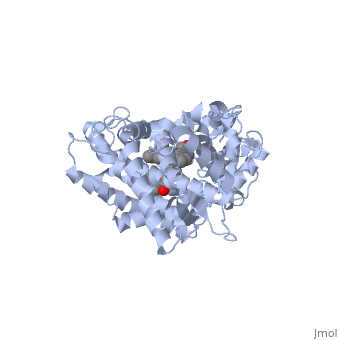2hi4
From Proteopedia
Crystal Structure of Human Microsomal P450 1A2 in complex with alpha-naphthoflavone
Structural highlights
FunctionCP1A2_HUMAN Cytochromes P450 are a group of heme-thiolate monooxygenases. In liver microsomes, this enzyme is involved in an NADPH-dependent electron transport pathway. It oxidizes a variety of structurally unrelated compounds, including steroids, fatty acids, and xenobiotics. Most active in catalyzing 2-hydroxylation. Caffeine is metabolized primarily by cytochrome CYP1A2 in the liver through an initial N3-demethylation. Also acts in the metabolism of aflatoxin B1 and acetaminophen. Participates in the bioactivation of carcinogenic aromatic and heterocyclic amines. Catalizes the N-hydroxylation of heterocyclic amines and the O-deethylation of phenacetin.[1] Evolutionary ConservationCheck, as determined by ConSurfDB. You may read the explanation of the method and the full data available from ConSurf. Publication Abstract from PubMedMicrosomal cytochrome P450 family 1 enzymes play prominent roles in xenobiotic detoxication and procarcinogen activation. P450 1A2 is the principal cytochrome P450 family 1 enzyme expressed in human liver and participates extensively in drug oxidations. This enzyme is also of great importance in the bioactivation of mutagens, including the N-hydroxylation of arylamines. P450-catalyzed reactions involve a wide range of substrates, and this versatility is reflected in a structural diversity evident in the active sites of available P450 structures. Here, we present the structure of human P450 1A2 in complex with the inhibitor alpha-naphthoflavone, determined to a resolution of 1.95 A. alpha-Naphthoflavone is bound in the active site above the distal surface of the heme prosthetic group. The structure reveals a compact, closed active site cavity that is highly adapted for the positioning and oxidation of relatively large, planar substrates. This unique topology is clearly distinct from known active site architectures of P450 family 2 and 3 enzymes and demonstrates how P450 family 1 enzymes have evolved to catalyze efficiently polycyclic aromatic hydrocarbon oxidation. This report provides the first structure of a microsomal P450 from family 1 and offers a template to study further structure-function relationships of alternative substrates and other cytochrome P450 family 1 members. Adaptations for the oxidation of polycyclic aromatic hydrocarbons exhibited by the structure of human P450 1A2.,Sansen S, Yano JK, Reynald RL, Schoch GA, Griffin KJ, Stout CD, Johnson EF J Biol Chem. 2007 May 11;282(19):14348-55. Epub 2007 Feb 20. PMID:17311915[2] From MEDLINE®/PubMed®, a database of the U.S. National Library of Medicine. Loading citation details.. Citations No citations found See AlsoReferences
|
| |||||||||||||||||||
Categories: Homo sapiens | Large Structures | Johnson EF | Reynald RL | Sansen S | Schoch GS | Stout CD | Yano JK


